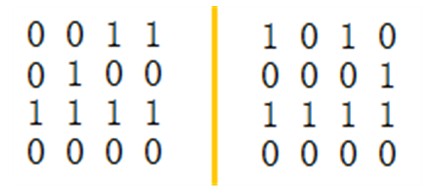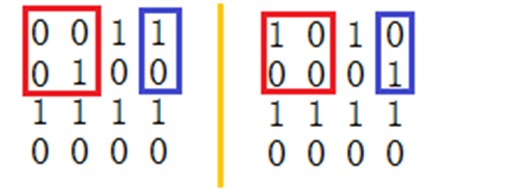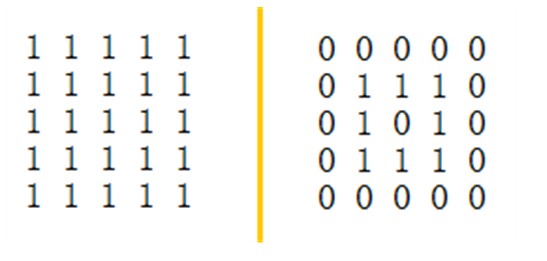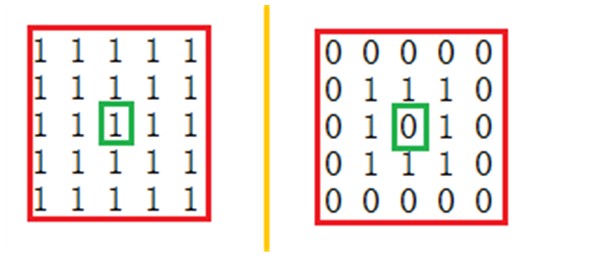
| Online Judge | Online Exercise | Online Teaching | Online Contests | Exercise Author |
|
F.A.Q Hand In Hand Online Acmers |
Best Coder beta VIP | STD Contests DIY | Web-DIY beta |
Find the Difference
Time Limit: 2000/1000 MS (Java/Others) Memory Limit: 32768/32768 K (Java/Others)Total Submission(s): 508 Accepted Submission(s): 219
Problem Description
Big Yuer was boring at home during his winter vacation, so he started to play ¡°Find the Difference with beautiful girls¡± in QQgame.
However, experts are all over the Internet! Big Yuer was beaten again and again.
The evil inside his body began to grow, he decided to make a cheater (matlab version), and he suddenly had a far sight.
This is the working cheater, and the highlighted ones are the differences.

However, he encountered some problems, which need your help.
Suppose two pictures are N*M integer matrix, we define ¡°Trouble Rectangle¡± between this two as these rectangles: First, the different pixel between them must be in some ¡°Trouble Rectangle¡±; second, there might be some same pixels inside a ¡°Trouble Rectangle¡±, but the pixels of the outer boundary must be same in two pictures (the outer boundary means the frame ¡°Trouble Rectangle¡± produces when expanding 1 pixel larger, except those out side the picture); next, a ¡°Trouble Rectangle¡± cannot be included in any other ¡°Trouble Rectangle¡± and cannot be intersect or adjacent to any other ¡°Trouble Rectangle¡±; at last, each ¡°Trouble Rectangle¡± must be unable to break down into smaller ¡°Trouble Rectangles¡±.
Take two 4*4 pictures as example:

In this picture, there are two ¡°Trouble Rectangles¡±, shown in below.

We cannot take (2,2)-(2,2) as a ¡°Trouble Rectangle¡± because its outer boundary in two pictures is not same, also we cannot take (1,1)-(2,4) as ¡°Trouble Rectangle¡± because it can break down into (1,1)-(2,2) and (1,4)-(2,4).
Take a 5*5 one as another example.

There is only one ¡°Trouble Rectangle¡±, shown in the red line below.

Because (3,3)-(3,3) is included in (1,1)-(5,5), so it¡¯s not a ¡°Trouble Rectangle¡±.
However, experts are all over the Internet! Big Yuer was beaten again and again.
The evil inside his body began to grow, he decided to make a cheater (matlab version), and he suddenly had a far sight.
This is the working cheater, and the highlighted ones are the differences.

However, he encountered some problems, which need your help.
Suppose two pictures are N*M integer matrix, we define ¡°Trouble Rectangle¡± between this two as these rectangles: First, the different pixel between them must be in some ¡°Trouble Rectangle¡±; second, there might be some same pixels inside a ¡°Trouble Rectangle¡±, but the pixels of the outer boundary must be same in two pictures (the outer boundary means the frame ¡°Trouble Rectangle¡± produces when expanding 1 pixel larger, except those out side the picture); next, a ¡°Trouble Rectangle¡± cannot be included in any other ¡°Trouble Rectangle¡± and cannot be intersect or adjacent to any other ¡°Trouble Rectangle¡±; at last, each ¡°Trouble Rectangle¡± must be unable to break down into smaller ¡°Trouble Rectangles¡±.
Take two 4*4 pictures as example:

In this picture, there are two ¡°Trouble Rectangles¡±, shown in below.

We cannot take (2,2)-(2,2) as a ¡°Trouble Rectangle¡± because its outer boundary in two pictures is not same, also we cannot take (1,1)-(2,4) as ¡°Trouble Rectangle¡± because it can break down into (1,1)-(2,2) and (1,4)-(2,4).
Take a 5*5 one as another example.

There is only one ¡°Trouble Rectangle¡±, shown in the red line below.

Because (3,3)-(3,3) is included in (1,1)-(5,5), so it¡¯s not a ¡°Trouble Rectangle¡±.
Input
Multiple test cases (no more than 10), for each case:
The first line contains two integers n and m£¨n,m <=50£©, representing height and length respectively.
Then input two n*m matrix, each number in the matrix is between 0 and 255 inclusive.
The first line contains two integers n and m£¨n,m <=50£©, representing height and length respectively.
Then input two n*m matrix, each number in the matrix is between 0 and 255 inclusive.
Output
For each case:
The first line has one integer X, represent the number of ¡°Trouble Rectangle¡±.
Following X line, each line output for integers xi1, yi1, xi2 and yi2, representing the coordinate of the top-left and bottom-right points. Output the one with smallest xi1 first, if there¡¯s a tie, output the smallest yi1 first.
The first line has one integer X, represent the number of ¡°Trouble Rectangle¡±.
Following X line, each line output for integers xi1, yi1, xi2 and yi2, representing the coordinate of the top-left and bottom-right points. Output the one with smallest xi1 first, if there¡¯s a tie, output the smallest yi1 first.
Sample Input
4 4 0 0 1 1 0 1 0 0 1 1 1 1 0 0 0 0 1 0 1 0 0 0 0 1 1 1 1 1 0 0 0 0 5 5 1 1 1 1 1 1 1 1 1 1 1 1 1 1 1 1 1 1 1 1 1 1 1 1 1 0 0 1 0 1 0 1 1 1 1 1 1 0 1 1 1 1 1 1 1 1 1 1 0 0
Sample Output
2 1 1 2 2 1 4 2 4 2 1 1 3 4 5 4 5 5
Author
zhanyu
Source
| Home | Top |
Hangzhou Dianzi University Online Judge 3.0 Copyright © 2005-2024 HDU ACM Team. All Rights Reserved. Designer & Developer : Wang Rongtao LinLe GaoJie GanLu Total 0.000000(s) query 1, Server time : 2024-11-22 17:31:51, Gzip enabled |
Administration |